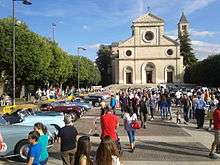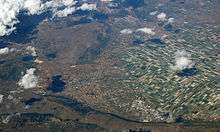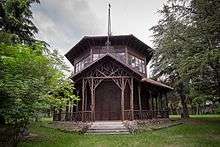Avezzano
| Avezzano | ||
|---|---|---|
| Comune | ||
| Città di Avezzano | ||
|
View of Avezzano from mount Salviano | ||
| ||
 Avezzano Location of Avezzano in Italy | ||
| Coordinates: 42°02′28″N 13°26′23″E / 42.04111°N 13.43972°ECoordinates: 42°02′28″N 13°26′23″E / 42.04111°N 13.43972°E | ||
| Country | Italy | |
| Region | Abruzzo | |
| Province / Metropolitan city | L'Aquila (AQ) | |
| Frazioni | Antrosano, Castelnuovo, Cese dei Marsi, Paterno, San Pelino, San Giuseppe di Caruscino, Borgo Incile, Borgo Via Nuova[1] | |
| Government | ||
| • Mayor | Giovanni Di Pangrazio | |
| Area | ||
| • Total | 104.04 km2 (40.17 sq mi) | |
| Elevation | 695 m (2,280 ft) | |
| Population (2016)[2] | ||
| • Total | 42,487 | |
| • Density | 410/km2 (1,100/sq mi) | |
| Demonym(s) | Avezzanesi | |
| Time zone | CET (UTC+1) | |
| • Summer (DST) | CEST (UTC+2) | |
| Postal code | 67051 | |
| Dialing code | 0863 | |
| Patron saint | Bartholomew the Apostle and Madonna of Pietraquaria | |
| Saint day | 24 August and 27 April | |
Avezzano ![]() listen (Italian pronunciation: [avetˈtsaːno] or [avedˈdzaːno]) is a city and comune with a population of about 42,500 inhabitants,[2] situated in the Abruzzo region, province of L'Aquila.[3] It is the second most populous province and the sixth in the region. Documented as an existing urban center in the ninth century. The city was destroyed by the earthquake of 1915. It was rebuilt again after the 1944 Allied bombing. The city was decorated with the silver medal for civil merit, an award granted by the Italian Republic.[4][5]
listen (Italian pronunciation: [avetˈtsaːno] or [avedˈdzaːno]) is a city and comune with a population of about 42,500 inhabitants,[2] situated in the Abruzzo region, province of L'Aquila.[3] It is the second most populous province and the sixth in the region. Documented as an existing urban center in the ninth century. The city was destroyed by the earthquake of 1915. It was rebuilt again after the 1944 Allied bombing. The city was decorated with the silver medal for civil merit, an award granted by the Italian Republic.[4][5]
It is the main commercial, industrial and agricultural centre of the Marsica area, with important high-tech industries and a large Telespazio satellite farm.
History
Toponymy
There are different common etymologies for the name of the city: from "Ad Vetianum" which means a "to the Vetia family"; from "Avidianum" or "fundus Avidianus" which is derived from the noble Avidius domiciled in the nearby town of Alba Fucens or from "Ave Jane", an invocation to the Roman god Janus.[6][7]
Earliest history

The presence of hunters dating back to the palaeolithic period about 18 to 14,000 years ago. They see several sites that bear witness to the presence of humans in prehistoric times as the Cave of Ciccio Felice located just south of Avezzano.[8] First major settlements in this area began with the construction works for the lake's drainage ordered by Emperor Claudius in the first century A.D.
Middle Ages
In 591 in the area came under the control of Ariulf and the duchy of Spoleto. Charlemagne, after the mid-700, donated Gastald of the Marsi and all the lands of the duchy to the papal states. So originated the county of the Marsi. In the late middle ages the victory of Charles of Anjou determines the destruction of Albe and Pietraquaria whose people had sided in favor of Conradin, duke of Swabia, defeated after the battle of Tagliacozzo in 1268.[9][10] In the fourteenth century ends in Avezzano the process of aggregation of the various villages that make up the urban center.[11]
Early modern
In the 15th century Avezzano was under Gentile Virginio Orsini, who built the castle in 1490.In the fifteenth century there was the victory of Colonna family on Orsini. Their lordship lasted about three centuries. The castle of Avezzano in 1565 expanded by Marcantonio Colonna and later converted into a fortified palace.[12]
Late modern and contemporary
Avezzano once lay on the shores of the largest lake in peninsular Italy, Lake Fucino, which was drained in the late 19th century. After the draining of the Lake, wide fields became available for cultivation and the area underwent terrific growth. It was completely destroyed by one of the worst recorded earthquakes in the history of Italy on the early morning of January 13, 1915 with only Palazzi's house and a wing of Orsini-Colonna castle spared. More than 30,000 people died. The town streets were then completely rebuilt along straight, parallel lines, with wide green areas and villas in the "Liberty" style.[13]
Geography

The city is located north-west of the Fucino. It is dominated in the north by Mount Velino and west from Mount Salviano. Avezzano is considered "the city territory" Marsica, Abruzzo sub-region that includes 37 municipalities, for a total of about 134,000 inhabitant.[14] The city is located about 100 kilometers east of Rome,[15] 110 west of Pescara[15] and 55 south of L'Aquila.[15]
Topography
The city is situated between 695 meters s.l.m. the urban sector and 740 in the north. The urban system of the old city revolves around the castle Orsini. To the east the territory extends to the villages of San Pelino and Paterno. It is situated between 695 meters s.l.m. the urban sector and 740 in the north. The land on which is a slight uphill slope with north-northwest.
Climate
Because of the geographical location, situated as it is at the former bed of the Fucino and surrounded by towering hills, Avezzano is characterized by a Mediterranean mountain climate. Based on climatic averages officers for the period 1951-2000 published by the agency ARSSA (Regione Abruzzo), and climatic averages officers related to thirty years of reference 1961-1990, the average temperature of the coldest month, January stood at +2,0 °C; that of the hottest month, August, the +20.5 °C. In summer sometimes exceed 30 °C but, with a moisture content and relative ventilation.[16] The Climate classification is: Zone E, 2561 GR / G.
Main sights



The city completely destroyed by the earthquake of 1915 has no monuments of particular interest as other locations in the region Abruzzo. However, you can see some important remains of its ancient history.
Orsini-Colonna castle
The castle was built in 1490 by Gentile Virginio Orsini, who had it built around a pre-existing medieval tower of the twelfth century. Probably the project of the castle was the engineer Francesco di Giorgio Martini. In the sixteenth century the castle was expanded by the will of Marcantonio Colonna becoming an elegant residence. Severely damaged by the earthquake of 1915, it was restored after 1990.[17]
Tunnels of Claudius
The tunnels are located south of the city. They were built by the emperor Claudius between 42 and 51 BC to realize the underground tunnel with which the emperor made the first attempt at draining the huge Lake Fucino. To create the tunnels and the main gallery, 25,000 slaves were needed. They dug 32 wells and six tunnels. The lake was largely drained, but with the fall of the Roman Empire the tunnels were obstructed and the lake returned to its previous levels. Many centuries later, Alessandro Torlonia completed the work by finally draining Lake Fucino, building on the original project of the emperor Claudius, turning the land under the great lake into a fertile plain. In 1977, the tunnels were opened as an archaeological park.[18]
Cathedral of San Bartolomeo
The Cathedral of St. Bartholomew was built in 1000 and documented in the thirteenth century. After its destruction as a result of the earthquake of 1915, it was rebuilt after 1940 in the new central square of Avezzano. The facade is neo-Renaissance travertine. The three portals are topped with mosaics depicting Christ and the two protectors of Avezzano, the Virgin Mary and St. Bartholomew. The church inside presents three large naves and a valuable organ placed in the church in 1955.[19]
Sanctuary of Madonna Pietraquaria
The original church was destroyed by Charles I of Anjou after the battle of Tagliacozzo in 1268 and rebuilt a few centuries later. In 1915, it did not suffer serious damage and was home to the survivors of the quake.[20]
Alba Fucens
7 kilometers north of the city is situated the Roman archaeological site of Alba Fucens. It was founded by Rome as a Latin colony between 304 and 303 BC in the territory of the Aequi, though on the frontier of the Marsi, in a strategic position. It is on a hill just north of the Tiburtina-Valeria, the ancient road from Rome to the Adriatic regions. The excavations were carried out since 1949 by the University of Leuven in Belgium led by professor Fernand De Visscher.[21]
Nature reserve of Mount Salviano
The nature park, established in 1999, covers 722 hectares west of the town of Avezzano on Mount Salviano. It has a rich variety of plants and different animal species that characterize its fauna and flora. At the center of the reserve is located the Sanctuary of the Madonna of Pietraquaria surrounded by numerous trails frequented by sportsmen and nature lovers.[22]
- Church of San Giovanni
- Torlonia Palace
- Liberty Justice Palace
Economy
Agriculture



Many farms in the plain of Fucino are distinguished by the quality of the vegetables. Particularly popular is the Fucino potato which obtained the recognition of the quality label "Protected Geographical Indication".[23] Several qualities of vegetables: carrot highland Fucino (PGI),[24] radishes, salads and all kinds of horticultural products. In Abruzzo, 25% of agricultural GDP comes from Fucino plain.[25]
Industry
Built in the seventies just outside the city in the direction Luco dei Marsi, the core industrial includes numerous industrial and manufacturing merchandise and is the economic engine of the province. Among these Micron Technology and L-Foundry, giants electronics manufacturing highly specialized. In fab "Innovation & Technology" on Avezzano they work 1,600 workers. They operate, also, the Arab TV, Kidco, the Burgo group, the Fiamm, the Saes, the Presider, the Presafer and several other specialist firms.[26] Not too far, in the Fucino plain, is located Telespazio satellite farm, one of the major global operators in satellite services.[27]
Commerce
It plays a very important role for the city in retail trade, service industry and traditional service industry. Large commercial areas are located on the Tiburtina Valeria street, between Roma street and Cappelle dei Marsi and along XX Settembre street, just outside the city. The so-called "natural shopping center" consists of the activities of the city center.
Tourism
Near Avezzano there are parks, valleys and cities. Natural beauty and architectural Abruzzi mountains: National Park of Abruzzo, Lazio and Molise, Sirente-Velino Regional Park, Fucino plain, Mount Velino, Ovindoli, Tagliacozzo, Giovenco valley, Roveto valley and Cavaliere plain.
Sports
The football squad is Avezzano Calcio who play at the Stadio dei Marsi. The rugby team is Avezzano Rugby.
Notable people
- Paola Concia, politician
- Felice Orlandi, actor
- Ada Gentile, pianist and composer
- Lino Guanciale, actor
- Gianni Letta, politician and journalist
- Mario Pescante, politician and sports manager
- Vito Taccone, cyclist
International relations
Avezzano is twinned with:
 Ayacucho, Peru, for the sustainable development of protected areas near to urban areas[28]
Ayacucho, Peru, for the sustainable development of protected areas near to urban areas[28]  Belén, Argentina, for cooperation and exchange of tourism, export and import food industry[29]
Belén, Argentina, for cooperation and exchange of tourism, export and import food industry[29] Santa María, Argentina, for cooperation and exchange of tourism, export and import food industry[29]
Santa María, Argentina, for cooperation and exchange of tourism, export and import food industry[29]
See also
- 1915 Avezzano earthquake
- Cathedral of San Bartolomeo
- Fucine Lake
- Marsica
- Orsini-Colonna castle
- Roman Catholic Diocese of Avezzano
References
- ↑ "Comune di Avezzano" (in Italian). Comuni-Italiani.it (Prometheo Srl). Retrieved 22 November 2016.
- 1 2 "Bilancio demografico anno 2015 (dati provvisori) - Avezzano". ISTAT. 31 May 2016. Retrieved 24 September 2016.
- ↑ "Avezzano" (in Italian). Il Portale d'Abruzzo. Retrieved 22 November 2016.
- ↑ "70 anni dalla liberazione (pag.30)" (PDF). ANPI.
- ↑ Palmieri, p. 106.
- ↑ "Il nome Avezzano". Terre Marsicane (Giovanni Pagani). Retrieved 20 January 2016.
- ↑ Febonio, p. 70.
- ↑ "Aspetti della morfologia carsica (anno 2006, pag.46)" (PDF). Ezio Burri (C.Giraudi/L.Piccini/P.Messina).
- ↑ "Gastaldato dei Marsi". Comune di Avezzano. Retrieved 21 January 2016.
- ↑ "Contea dei Marsi". Pereto.info.
- ↑ "Una missionaria nell'Avezzano del '700-Madre Maria Teresa Cucchiari e la sua opera (Giuseppe Grossi)" (PDF). Sobriaebbrezza.it. Retrieved 21 January 2016.
- ↑ "Castello Orsini-Colonna". Regione Abruzzo. Retrieved 21 January 2016.
- ↑ "Touristic Guide of Avezzano". Comune di Avezzano. Retrieved 16 January 2016.
- ↑ "Dati Popolazione, Superficie e Densità dei Comuni appartenenti alle Comunità Montane Abruzzesi" (PDF). Regione Abruzzo. Retrieved 22 January 2016.
- 1 2 3 Distance provided by Google Maps: Fastest route
- ↑ "Analisi spazio temporali delle precipitazioni nella Regione Abruzzo" (PDF). Regione Abruzzo. Retrieved 22 January 2016.
- ↑ "Castello Orsini-Colonna". Regione Abruzzo.
- ↑ "Cunicoli di Claudio". Regione Abruzzo. Retrieved 27 January 2016.
- ↑ "Chiesa di San Bartolomeo in Avezzano". terremarsicane.it.
- ↑ "Santuario della Madonna di Pietraquaria". diocesidiavezzano.it. Retrieved 3 February 2016.
- ↑ "Alba Fucens". albafucens.info.
- ↑ "Scrigno di biodiversità". tesoridabruzzo.com. Retrieved 3 February 2016.
- ↑ "IGP Patata del Fucino". AgricolturaOggi.com.
- ↑ "Abruzzo, il gusto della carota del Fucino (Ricette prodotti Igp Italia)". La Stampa (Turismo.it).
- ↑ "Cuore d'Abruzzo: 25% PIL agricolo dal Fucino". Il Centro.
- ↑ "Consorzio nucleo industriale di Avezzano". Consorzio nucleo industriale di Avezzano.
- ↑ "Fucino: the largest civil space centre in the world". Telespazio.com.
- ↑ "Gemellaggio tra la città di Avezzano e Ayacucho". TeleSirio. Retrieved 21 January 2016.
- 1 2 Marsica Live. "Gemellaggio Avezzano-Belén-Santa María" (in Italian).
Bibliography
- Febonio, Muzio (1678). Historiae Marsorum (in Latin). Monaco di Baviera: Biblioteca Pubblica Bavarese.
- Palmieri, Eliseo (2006). Avezzano, un secolo di immagini (in Italian). Pescara: Paolo de Siena editore.
External links
| Wikimedia Commons has media related to Avezzano. |
| Wikivoyage has a travel guide for Avezzano. |
- Institutional website Comune di Avezzano (Italian)
- Weather forecast Ministero della difesa - Aeronautica (Italian)

